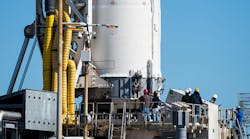Orbital ATK’s Cygnus cargo ship arrived at the International Space Station on Wednesday, carrying more than 7,000 pounds of water, food and supplies for global astronauts.
“Capture confirmed,” a NASA commentator said at 6:19 a.m. EST, as NASA astronaut Kjell Lindgren, operating the Canadian-made robotic arm from inside the space station, reached out and grabbed the beer-keg shaped spaceship. “Cygnus has arrived at the station.”
Following the capture, the spaceship will slowly be brought closer to the ISS to be bolted securely on in the coming hours. Astronauts plan to dive into the contents of the Cygnus and begin unpacking it early Thursday, NASA said.
The spaceship launched Sunday from Cape Canaveral, Fla., atop an Atlas V rocket built by United Launch Alliance.
Orbital has not sent a cargo spaceship to orbit since October 2014, when its Antares rocket exploded shortly after liftoff due to a problem with its Ukrainian-made engine.
Both Orbital ATK and SpaceX have billion-dollar contracts with NASA to supply the ISS over a series of cargo missions with their Cygnus and Dragon spaceships.
Japan Enters Venus’ Orbit
In other space news, the Japan Aerospace Exploration Agency announced Wednesday that its “Akatsuki” probe had successfully entered into orbit around Venus after an initial attempt at reaching the planet failed five years ago.
The success marks the first time a Japanese space probe has entered into the orbit of another planet, according to JAXA.
“The probe is functioning properly,” JAXA project manager Masato Nakamura said during a press conference. ”We’ll conduct an initial observation for three months. ... We’ll then shift to full observation in April.”
Akatsuki, which translates to “dawn”, blasted off in 2010 on a 25.2 billion yen ($206.60 million) mission to observe the toxic atmosphere and super-hot volcanic surface of Venus. But the box-shaped probe failed to enter the planet’s gravitational pull and shot past it, forcing JAXA technicians to make the second attempt.
Copyright Agence France-Presse, 2015




